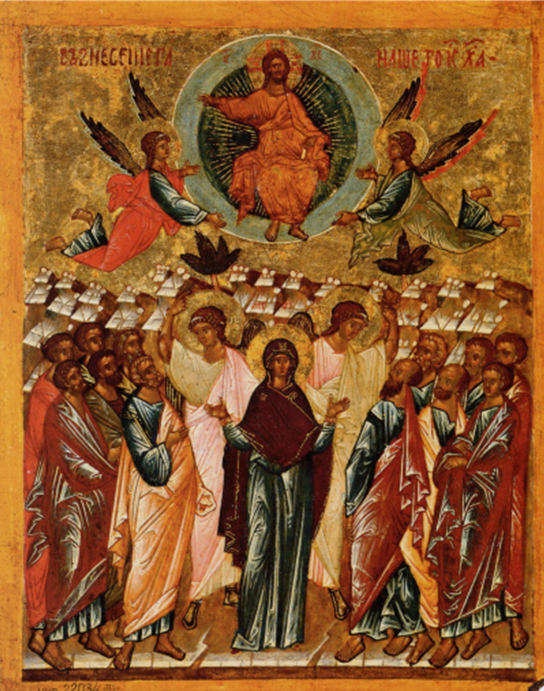THE ASCENSION

"... and ASCENDED into heaven ..." The ASCENSION of Christ is His final physical departure from this world after His Resurrection. The Lord leaves in order to be glorified with God the Father and to glorify us with Himself. During forty days (forty days is used many times in the Bible and signifies a temporal period of completeness), the Lord "appears" to the disciples, from time to time, and always in a miraculous and mysterious manner. The ASCENSION Icon shows Christ, with angels, being escorted back to His heavenly home. Although the icon shows the events as described in the Book of Acts (1:12) and Luke (24:50-53), it is not meant to be a historical picture, but a representation of the Church (The Apostle Paul who was still Saul is standing next to Mary). The image itself is characterized by colour: the robes of the Apostles, the Mother of God, the Angels, and Christ Himself surrounded by light. The icon contains both confusion and peace: the former is borne of worldly reasoning, while the latter comes from divine, heavenly, order. The Apostles look up in a combination of fear and wonder. In the centre, the two angels “in white apparel” exhort the men to cease their gazing into heaven and return to Jerusalem to receive the promised gift of the Holy Spirit. Between the two angels stands Mary the Mother of God, hands raised in prayer. Already overshadowed by the Holy Spirit since Christ’s conception, Mary appears to understand the deep mysteries of her Son’s birth, death, resurrection and ascension, already hoping on Christ’s return. The Theotokos represents the entire Church waiting for Jesus' return. Even though we see Christ departing, the Orthodox Church sees the Second and Glorious Coming in the same icon.
L’ ASCENSION
«...est monté au ciel... » Nous célébrons l’Ascension quarante jours après Pâques (le nombre 40 est récurrent dans la Bible ; il symbolise un temps d’attente, d’épreuve ou d’apprentissage). Cette Fête marque le dernier jour de la présence physique du Christ ressuscité parmi Ses disciples après avoir été mis sur la Croix, Son élévation au ciel. L’Ascension couronne Sa mission terrestre, la mission qu’il avait reçue du Père. Elle symbolise un nouveau mode de présence du Christ, qui n’est plus visible dans le monde terrestre, mais qui demeure présent dans les sacrements. L’icône de l’ASCENSION montre l’ÉLÉVATION du Christ auprès de Son Père, bénissant et promettant aux apôtres la venue du Saint-Esprit. Le Christ est rayonnant de Gloire, soutenu dans Son envol par deux anges. Bien que l’icône représente les événements décrits dans le livre des Actes (1:12) et dans Luc (24: 50-53), il ne s’agit pas d’un tableau historique, mais bien d’une représentation de l’Église: l’apôtre Paul, à la gauche de la Mère de Dieu est présent, alors qu’il n’a pas vécu avec le Christ avant Sa Passion. Avec son témoignage de la Résurrection qu’il reçut sur le chemin de Damas, il représente les fidèles qui dans l’Église, et à travers les siècles, confessent le Christ. Marie est située juste au-dessous du Christ ; elle occupe la place centrale du bas de l’icône, immobile, en attitude de prière et d’intercession. Elle semble comprendre les mystères profonds de la naissance, de la mort, de la résurrection et de l’ascension de son Fils. Elle représente toute l’Église qui attend le retour de Jésus. Les deux anges blancs au milieu des apôtres annoncent que le Christ reviendra dans Sa Gloire. Même si nous voyons le Christ « monter », l’Église orthodoxe voit dans la même icône la seconde et glorieuse venue du Christ.